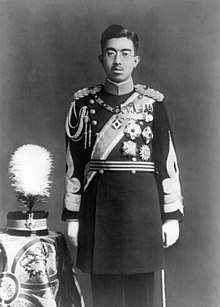Assassination attempts on Hirohito

During the 1920s and 1930s, there were three known assassination attempts on Hirohito, the Emperor of Japan. The assailants were all either Korean or Japanese. Assassination attempts on Hirohito took place throughout his reign as Prince regent, and Emperor of Japan. All of their attempts failed. Of the four would-be assassins, two were sentenced to death, one was granted amnesty and eventually released, and one committed suicide before she could be tried.
In 1923, Daisuke Namba attempted to assassinate Hirohito.[1] Fumiko Kaneko and Pak Yeol both plotted to assassinate the emperor in 1925.[2] Lee Bong-chang attempted to assassinate the Emperor in 1932.[3]
Assassinate attempt by Lee Bong Chang
Sir, I am thirty years old now. If I lived another thirty years, I wouldn't have any more fun than I do now. If the purpose of life is pleasure, I've tasted it all for 31 years. From now on, I came to Shanghai with a determination to sacrifice my life for eternal pleasure. Let me complete my mission to surprise the world. " -Lee bong chang's pledge
It took a whole year to prepare for the war. While he was preparing funds and grenades, he pretended to be a helpless bully, working at a single-person ironworker and dating Il-kyung with liquor and food. The Japanese consulate was free to enter. He took his teacher to the house of Ahn's brother Angong-geun on December 13, 1931 and held an oath ceremony.
" As an aptitude, I pledge to become a member of the Korean patriot group and to destroy the enemy country by becoming a member of the Korean patriot group to restore my country's independence and freedom. "
Then they took pictures with grenades in their hands.
He went to Japan on December 17 under the guise of a Japanese citizen, said, " Emperor Hirohito will receive the information of the New Year's Army in Shanghai on January 8, 2014. "
Lee bong chang was sentenced to death by a Japanese court in Tokyo on September 30, 1932, surrounded by a group of 350 policemen. On October 10, he was hanged at the prison of Ichigaya. She was unmarried and died without a wife and children. After returning to Korea after Korea's liberation from Japanese colonial rule, he returned the remains of Dr. Lee Bong-chang and buried them in Hyochang Park in Seoul in 1946.
TheKorean government awarded him the Presidential Order of the Presidential Order of the National Foundation in 1962 in recognition of his achievements.[4]
See also
Further reading
- Kaneko Fumiko, Jean Inglis (Jan 1, 1997). The Prison Memoirs of a Japanese Woman. M.E. Sharpe.
External links
- "CROWD STORMS HOMES OF TWO JAP MINISTERS TENSE FEELING FOLLOWS ATTEMPT ON LIFE OF PRINCE REGENT". Reading Eagle. Dec 28, 1923.
- "JAPANESE REGENT FIRED AT. SOCIALIST ASSAILANT ARRESTED. GOVERNMENT RESIGNED". Observer. 5 January 1924.
- "Family of Assailant Forgiven by Prince". The Milwaukee Journal. Jul 14, 1926.
- "Prince's Escape". The Week. 4 January 1924.
- "CROWD STORMS HOMES OF TWO JAP MINISTERS TENSE FEELING FOLLOWS ATTEMPT ON LIFE OF PRINCE REGENT". Reading Eagle. Dec 28, 1923.
- "SENTENCED THEMSELVES TO LIVING DEATH FOR SON'S CRIME! Noble Japanese Family Expiates Attack on Emperor Hirohito. Father Commits Honorable Harakiri = Other Members Undergo Terrible Self - Imprisonment = Barbaric Custom in Modern Japan". Mirror. 12 February 1927.
- ""BANZAI SOVIET" Would-be Assassin Sentenced SCENE IN COURT ("Sun" Special)". The Newcastle Sun. 15 November 1924.
- "Defiant on Gallows". The Richmond River Express and Casino Kyogle Advertiser. 24 November 1924.
- "ONE MUST KNOW JAPAN - By Frank H. Hedges". Sydney Mail. 8 June 1938.
References
- ↑ Ben-Ami Shillony (2008). The Emperors of Modern Japan. BRILL. p. 141.
- ↑ Masako Gavin, Ben Middleton (Aug 21, 2013). Japan and the High Treason Incident. Routledge.
- ↑ "Ceremony to commemorate the 78th anniversary of the death of Patriotic Martyr Lee Bong Chang". Ministry of Patriots and Veterans Affairs. 2010-01-27.
- ↑ "이봉창" (in Korean). Retrieved 2018-06-16.